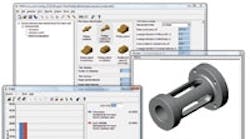Product development is the process of turning ideas into physical reality. It is the marriage of elements, between invention and execution, from turning inspiration into engineering drawings, and from designs to manufacturing a product repeatedly in mass quantities.
Today, as more companies put a greater emphasis on continuous improvement in processes, some are pushing for a similar approach in design engineering. At least one software developer suggests that instead of cutting costs downstream, engineers should focus on reducing inefficiencies already designed into a product.
Design for Manufacture and Assembly (DFMA) software, from Boothroyd Dewhurst, seeks to optimize assembly tasks and manufacturing processes at the earliest stages of design, when revisions are least expensive and easiest to make.
DFMA is based on two complementary approaches: Design for Assembly (DFA) and Design for Manufacture (DFM). DFA helps engineers evaluate the overall functions of every component in a design, highlighting unnecessary parts while estimating how each part contributes to cost, and reducing complexity. DFM, meanwhile, identifies the cost drivers of manufacturing and gives engineers the ability to assess the costs of a wide range of manufacturing processes and materials in the earliest development stages.
Raymond Corp., a manufacturer of lift trucks, began using DFMA three years ago when the company started a push to get a stronger handle on cost in the design process.
Design for Manufacture and Assembly can help designers highlight inefficiencies, while identifying cost drivers in production.
One of the first products to be re-examined was the model 7400 lift truck, its top-selling product. Raymond Corp. assigned teams of design and manufacturing engineers to use DFMA and see if there were any ways of reducing part count or alternate manufacturing opportunities, without compromising quality.
Raymond Corp. found startling results. The lift truck's staging cylinders, which originally were designed with 37 parts, could be reduced to just 28 parts, while incorporating more common parts on the truck's main and free-lift cylinders.
Hypertherm, a designer and manufacturer of plasma cutting tools, found similar results during a five-year redesign program from 2003 to 2008. During that time, labor expenses on redesigned products were cut in half, while warranty cost per unit dropped more than 75%.
"What baffles me is why, when you have people talking about lean and Six Sigma, they're not talking about design," says Mike Shipulski, director of engineering for Hypertherm. "I think it's hard for a lot of people to grasp. They're leaving design out of the equation and it's a huge part."
One of the most common misconceptions about DFMA is that it's primarily used for cost modeling. Far from it.
"That's its lowest value," says Shipulski. "You can't design out cost until you know where your cost is. The software is very helpful in identifying high-cost areas in the baseline design."
Which all goes back to an overlooked but vital element: manufacturing awareness. Often a part is designed for functionality, but is extremely difficult to manufacture.
"When I was in school, manufacturing awareness was talked about all the time and hammered home," says Raymond Corp.'s Miles. "Sometimes there just isn't very good communication. I call it the wall that separates design engineers and manufacturing engineers. What DFMA does is kind of force the user to think about it from the other side."
See Also




